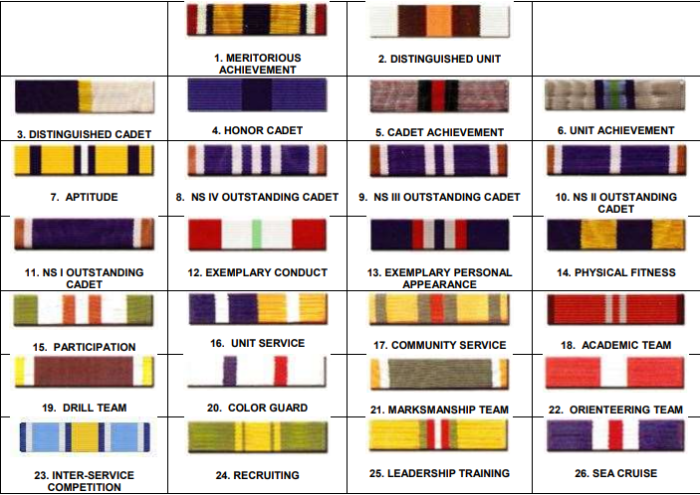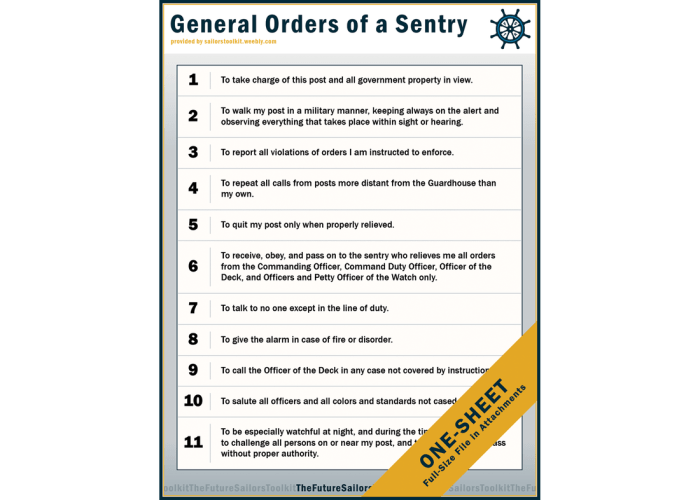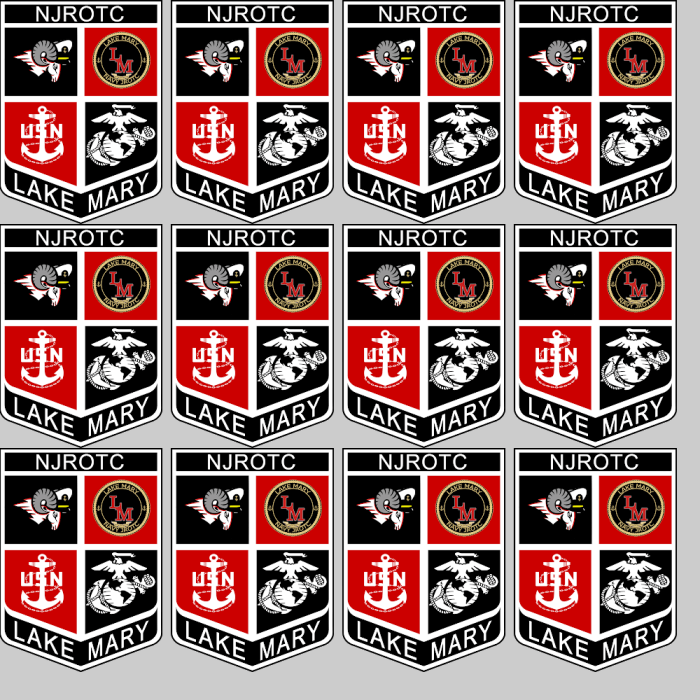NJROTC orders to the sentry serve as the cornerstone of effective sentry duty, providing clear instructions and guidance to ensure the safety and security of protected assets. These orders, both general and specific, form the backbone of sentry operations, dictating the proper execution of duties and the appropriate use of force when necessary.
Understanding and adhering to NJROTC orders to the sentry is paramount for sentries to carry out their responsibilities effectively. By following these orders diligently, sentries can maintain a high level of vigilance, respond appropriately to potential threats, and contribute to the overall security of their post.
General Orders

General orders are specific instructions given to sentries to guide their conduct and ensure the security of their post.
Following general orders is crucial because it:
- Maintains consistency and predictability in sentry duty.
- Promotes a sense of discipline and professionalism.
- Enhances the effectiveness of sentry duty by ensuring sentries perform their tasks uniformly.
Examples of General Orders
Some common general orders given to sentries include:
- Challenge all persons approaching the post.
- Remain alert and vigilant at all times.
- Report all suspicious activities to the appropriate authority.
- Do not leave the post unattended.
- Maintain a professional and courteous demeanor.
Specific Orders

In addition to general orders, sentries may also receive specific orders. These orders are unique to each post and may vary depending on the situation. Understanding specific orders is crucial for sentries to carry out their duties effectively.
Importance of Understanding Specific Orders
Specific orders provide clear instructions to sentries on what to do and how to do it. They help ensure that sentries are performing their duties in a consistent and effective manner. Specific orders also help to prevent confusion and misunderstandings between sentries and their supervisors.
Examples of Specific Orders, Njrotc orders to the sentry
Specific orders may include:
- Instructions on how to patrol a post
- Guidelines on how to handle visitors
- Procedures for responding to emergencies
- Instructions on how to use specific equipment
- Directives on how to report incidents
Execution of Orders
Executing orders properly is crucial for the success of any military operation. It ensures that tasks are completed efficiently, resources are used effectively, and objectives are achieved. Failure to execute orders correctly can have serious consequences, including mission failure, loss of life, or damage to equipment.
To execute orders effectively, it is essential to:
- Understand the order clearly. Ask for clarification if needed.
- Plan how to execute the order. Consider the resources and time required.
- Communicate the order to subordinates clearly and concisely.
- Monitor the execution of the order and make adjustments as necessary.
- Report back to the issuer of the order once it has been completed.
By following these steps, you can ensure that orders are executed properly and that the mission is accomplished successfully.
Consequences of Failing to Execute Orders Properly
Failing to execute orders properly can have serious consequences, including:
- Mission failure
- Loss of life
- Damage to equipment
- Disciplinary action
It is therefore essential to take all necessary steps to ensure that orders are executed correctly.
Examples of How to Execute Orders Effectively
Here are some examples of how to execute orders effectively:
- A platoon commander receives an order to move his platoon to a new location. He first clarifies the order with the battalion commander, then plans the route and timeline for the move. He communicates the order to his platoon, assigns tasks to each squad, and monitors the progress of the move.
Once the move is complete, he reports back to the battalion commander.
- A squad leader receives an order to clear a building. He first plans how to approach the building, then assigns each member of his squad a specific task. He communicates the order to his squad, then leads them into the building and clears it of enemy forces.
Once the building is clear, he reports back to his platoon commander.
These are just a few examples of how to execute orders effectively. By following these principles, you can ensure that orders are carried out correctly and that the mission is accomplished successfully.
Reporting Orders

Reporting orders is an essential aspect of military operations. It ensures that orders are communicated accurately and efficiently, allowing for a coordinated response to changing situations.
To report orders effectively, it is important to:
- Acknowledge the order.Respond with “aye” or “roger” to indicate that you have received the order.
- Repeat the order.Repeat the order back to the issuer to confirm that you have understood it correctly.
- State your understanding.Briefly summarize the key points of the order to demonstrate your comprehension.
- Request clarification.If there are any unclear aspects of the order, ask for clarification before proceeding.
Here are some examples of how to report orders effectively:
Order:“Proceed to the designated assembly point immediately.”
Report:“Aye, sir. I will proceed to the designated assembly point immediately.”
Order:“Establish a security perimeter around the target area.”
Report:“Roger, sir. I will establish a security perimeter around the target area. Do you require any specific parameters for the perimeter?”
If you’re interested in learning more about NJROTC orders to the sentry, you might find the discussion in Bless Me, Ultima Chapter 14 helpful. It delves into the specific instructions given to sentries and their responsibilities in maintaining security.
Challenging Orders: Njrotc Orders To The Sentry

A sentry may challenge an order if they have a valid reason to believe that the order is unlawful, immoral, or unethical. The sentry should approach the person giving the order in a respectful manner and explain their reasons for challenging the order.
The person giving the order should then explain their reasons for giving the order. If the sentry is still not satisfied, they may refuse to obey the order.
Proper Way to Challenge an Order
When challenging an order, the sentry should:
- Remain calm and respectful.
- State their name and rank.
- Explain their reason for challenging the order.
- Be prepared to provide evidence to support their claim.
- Follow the instructions of the person giving the order until the challenge is resolved.
Examples of How to Challenge an Order Effectively
Here are some examples of how to challenge an order effectively:
- “Sir/Ma’am, I am Sentry [sentry’s name], and I am challenging your order to [state the order]. I believe that this order is unlawful because [state the reason].”
- “Sir/Ma’am, I am Sentry [sentry’s name], and I am challenging your order to [state the order]. I believe that this order is immoral because [state the reason].”
- “Sir/Ma’am, I am Sentry [sentry’s name], and I am challenging your order to [state the order]. I believe that this order is unethical because [state the reason].”
Use of Force
The use of force by a sentry is a serious matter and should only be used as a last resort when all other options have been exhausted.
A sentry may use force to:
- Protect themselves or others from imminent harm.
- Prevent the unauthorized entry or exit of a person or vehicle.
- Enforce the rules and regulations of the post.
Proper Use of Force
When using force, a sentry must do so in a reasonable and necessary manner. The amount of force used must be proportional to the threat posed by the individual or situation.
A sentry should always attempt to de-escalate the situation and avoid using force if possible. However, if force is necessary, the sentry should use the minimum amount of force necessary to achieve their objective.
Examples of Effective Use of Force
Here are some examples of how a sentry can use force effectively:
- A sentry may use verbal commands to order an individual to stop or leave an area.
- A sentry may use physical force to restrain an individual who is attempting to harm themselves or others.
- A sentry may use deadly force to stop an individual who is posing an imminent threat to life.
User Queries
What is the purpose of general orders for sentries?
General orders provide sentries with broad guidelines and instructions that govern their overall conduct and behavior while on duty.
Why is it important to follow specific orders?
Specific orders provide sentries with detailed instructions for specific situations or tasks, ensuring that they carry out their duties in a consistent and effective manner.
What are the consequences of failing to execute orders properly?
Failure to execute orders properly can compromise the safety and security of the post, resulting in disciplinary action or even legal consequences.